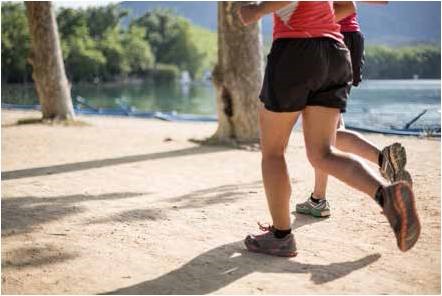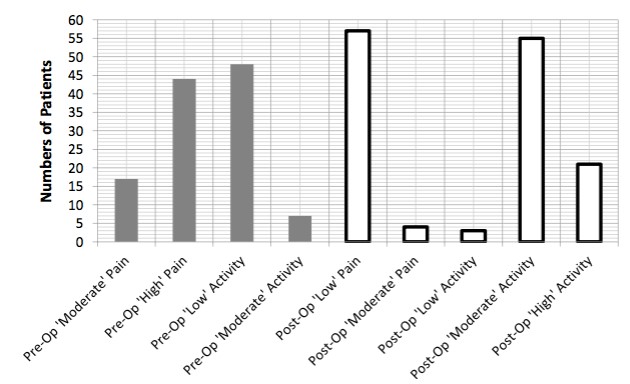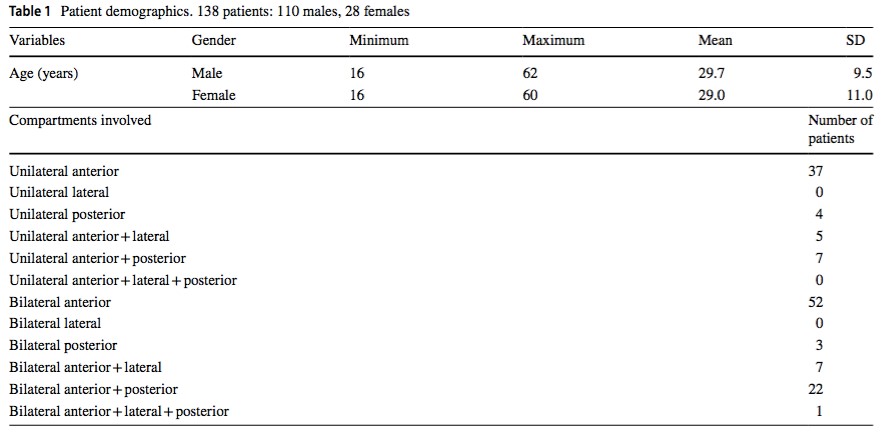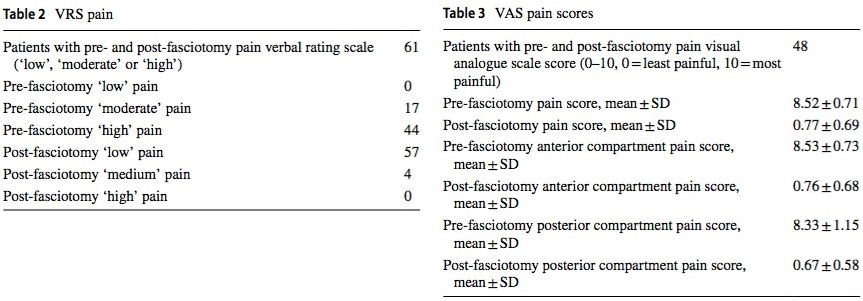
Introduction
Le syndrome des loges (SDL) est une pathologie pouvant causer des douleurs au cours de et après l’activité. La raideur, l’œdème et des engourdissements sont des symptômes communs, qui sont soulagés au repos chez la plupart des patients. Le SDL affecte en majorité une population active jeune, et fréquent chez les coureurs ou les militaires. La physiopathologie exacte n’est pas claire, mais la douleur serait due à une augmentation de la pression intra musculaire, menant à un défaut de perfusion puis à une douleur ischémique.
Le diagnostic du SDL est avant tout clinique, basé sur les symptômes du patient. Les diagnostics différentiels d’une douleur basse du segment jambier, chez une population active, peuvent comprendre une périostite, une fracture de fatigue, un piégeage nerveux ou vasculaire. Le SDL peut être différencier par une mesure de la pression intra compartimentale (PIC).
Le symptôme le plus dominant dans le SDL est la douleur, qui peut avoir un effet négatif sur les activités quotidiennes et la santé mentale. Le traitement conservateur comprend le repos, les étirements, la physiothérapie et la prescription d’orthèse. L’abord chirurgical comprend essentiellement la fasciotomie, avec parfois fasciectomie. La fasciotomie s’avère être une orientation chirurgicale satisfaisante pour les patients avec un SDL.
Plusieurs études rapportent que 70 à 100% des patients montrent une diminution voire une abolition des douleurs avec l’opération. Néanmoins, la plupart de ces études implique une petite population d’étude de sportifs professionnels ou de militaires, avec absence de données ou de mesures pré opératoires. La littérature comparant des variables telles que la PIC, les données auto rapportées du patient et les résultats de chirurgie, est assez pauvre.
Le syndrome des loges (SDL) est une pathologie pouvant causer des douleurs au cours de et après l’activité. La raideur, l’œdème et des engourdissements sont des symptômes communs, qui sont soulagés au repos chez la plupart des patients. Le SDL affecte en majorité une population active jeune, et fréquent chez les coureurs ou les militaires. La physiopathologie exacte n’est pas claire, mais la douleur serait due à une augmentation de la pression intra musculaire, menant à un défaut de perfusion puis à une douleur ischémique.
Le diagnostic du SDL est avant tout clinique, basé sur les symptômes du patient. Les diagnostics différentiels d’une douleur basse du segment jambier, chez une population active, peuvent comprendre une périostite, une fracture de fatigue, un piégeage nerveux ou vasculaire. Le SDL peut être différencier par une mesure de la pression intra compartimentale (PIC).
Le symptôme le plus dominant dans le SDL est la douleur, qui peut avoir un effet négatif sur les activités quotidiennes et la santé mentale. Le traitement conservateur comprend le repos, les étirements, la physiothérapie et la prescription d’orthèse. L’abord chirurgical comprend essentiellement la fasciotomie, avec parfois fasciectomie. La fasciotomie s’avère être une orientation chirurgicale satisfaisante pour les patients avec un SDL.
Plusieurs études rapportent que 70 à 100% des patients montrent une diminution voire une abolition des douleurs avec l’opération. Néanmoins, la plupart de ces études implique une petite population d’étude de sportifs professionnels ou de militaires, avec absence de données ou de mesures pré opératoires. La littérature comparant des variables telles que la PIC, les données auto rapportées du patient et les résultats de chirurgie, est assez pauvre.
Objectif
Le but de cette étude est d’évaluer les données auto rapportés du patient avant et après fasciotomie. Un objectif secondaire est d’identifier une potentielle relation entre la PIC et la douleur auto rapportée du patient.
Le but de cette étude est d’évaluer les données auto rapportés du patient avant et après fasciotomie. Un objectif secondaire est d’identifier une potentielle relation entre la PIC et la douleur auto rapportée du patient.
Méthode
L’étude inclut un total de 138 patients avec un diagnostic de SDL, entre Janvier 2010 et Mars 2017.
L’étude inclut un total de 138 patients avec un diagnostic de SDL, entre Janvier 2010 et Mars 2017.

Il a été mesuré en pré et post opératoire (les résultats sont exposés dans la charte ci après) :
- La douleur rapportée par le patient : avec une échelle d’évaluation verbale de la douleur (VRS) (faible, modérée ou importante), ou une échelle visuelle analogique (VAS) (de 0 à 10)
- Le niveau d’activité et les symptômes associés
- L’ICP du compartiment supposé incriminé.

Résultat
Les données démographiques des sujets sont regroupées dans le tableau ci-dessous :
Les données démographiques des sujets sont regroupées dans le tableau ci-dessous :

En tout, 109 patients ont rapporté un niveau de douleur, dont 61 ont utilisé le VRS et 48 le VAS. Le niveau d’activité pré opératoire a pu être mesuré chez 55 patients. Un total de 40 patients ont rapporté des symptômes associés.
Le score moyen pré opératoire du VAS est de 8,52 +/- 0,71. Le même score en post opératoire est en moyenne de 0,77 +/- 0,69.
Le score moyen pré opératoire du VAS est de 8,52 +/- 0,71. Le même score en post opératoire est en moyenne de 0,77 +/- 0,69.

Une corrélation positive non significative (r = 0,046, p = 0,76) a été trouvé entre la douleur au VAS et l’ICP. Une corrélation positive significative modérée (r = 0,497, p = 0,01) a été établie entre la douleur au VRS et l’ICP.
Conclusion
Dans une large cohorte de patient avec un SDL du membre inférieur induit par l’exercice, les auteurs ont démontré que le niveau de douleur et d’activité s’améliore après une fasciotomie, utilisant une approche mini invasive. Il a été trouvé une corrélation positive significative entre l’ICP et le score du VRS, et une corrélation positive, mais non significative, entre l’ICP et le score au VAS.
Mots clé : syndrome des loges, satisfaction du patient, résultat du patient, fasciotomie, pression compartimentale.
Article original :
J. P. H. Tam · A. G. F. Gibson · J. R. D. Murray · M Hassaballa. Fasciotomy for chronic exertional compartment syndrome of the leg: clinical outcome in a large retrospective cohort. European Journal of Orthopaedic Surgery & Traumatology https://doi.org/10.1007/s00590-018-2299-3
Références :
1. McLaughlin N, Heard H, Kelham S (2014) Acute and chronic compartment syndromes: know when to act fast. J Am Acad Phys Assist 27(6):23–26
2. Blackman PG (2000) A review of chronic exertional compart- ment syndrome in the lower leg. Med Sci Sports Exerc 32(3 Suppl):S4–S10
3. Brewer RB, Gregory AJ (2012) Chronic lower leg pain in athletes: a guide for the differential diagnosis, evaluation, and treatment. Sports Health 4(2):121–127
4. Davis DE, Raikin S, Garras DN, Vitanzo P, Labrador H, Espandar R (2013) Characteristics of patients with chronic exertional com- partment syndrome. Foot Ankle Int 34(10):1349–1354
5. Paik RS, Pepples D, Hutchinson MR (2013) Chronic exertional compartment syndrome. BMJ 346(7896):35–37
6. Dunn JC, Waterman BR (2014) Chronic exertional compart- ment syndrome of the leg in the military. Clin Sports Med 33(4):693–705
7. Murdock M, Murdoch MM (2012) Compartment syndrome: a review of the literature. Clin Podiatr Med Surg 29(2):301–310
8. Van der Wal WA, Heesterbeek PJ, Van den Brand JG, Verleisdonk EJ (2015) The natural course of chronic exertional compartment syndrome of the lower leg. Knee Surg Sports Traumatol Arthrosc 23(7):2136–2141
9. Styf JR, Korner LM (1987) Diagnosis of chronic anterior compart- ment syndrome in the lower leg. Acta Orthop Scand 58:139–144
10. Van den Brand JG, Verleisdonk EJ (2004) Near infrared spec- troscopy in the diagnosis of chronic exertional compartment syn-
drome. Am J Sports Med 32:452–456
11. Verleisdonk EJ, van Gils A, van der Werken C (2001) The diag-
nositc value of MRI scans for the diagnosis of chronic exer- tional compartment syndrome of the lower leg. Skeletal Radiol 30:321–325
12. Pedowitz RA, Hargens AR, Mubarak SJ, Gershuni DH (1990) Modified criteria for the objective diagnosis of chronic compart- ment syndrome of the leg. Am J Sports Med 18(1):35–40
13. Tiidus PM (2014) Is intramuscular pressure a valid diagnostic criterion for chronic exertional compartment syndrome? Clin J Sport Med 24(1):87–88
14. Roscoe D, Roberts AJ, Hulse D (2015) Intramuscular compart- ment pressure measurement in chronic exertional compartment syndrome: new and improved diagnostic criteria. Am J Sports Med 43(2):392–398
15. Stubhaug A, Breivik H (2016) Chronic compartment syndrome is an under-recognized cause of leg-pain. Scand J Pain 1(12):53–54
16. Gilmour H (2015) Chronic pain, activity restriction and flourish-
ing mental health. Health Rep 26(1):15
17. Gatzounis R, Schrooten MG, Crombez G, Vlaeyen JW (2014)
Interrupted by pain: an anatomy of pain-contingent activity inter-
ruptions. Pain 155(7):1192–1195
18. Orlin JR, Lied IH, Stranden E, Irgens HU, Andersen JR (2016)
Prevalence of chronic compartment syndrome of the legs: impli- cations for clinical diagnostic criteria and therapy. Scand J Pain 31(12):7–12
19. Beck JJ, Tepolt FA, Miller PE, Micheli LJ, Kocher MS (2016) Surgical treatment of chronic exertional compartment syndrome in pediatric patients. Am J Sports Med 44(10):2644–2650
20. Winkes MB, van Zantvoort AP, de Bruijn JA, Smeets SJ, van der Cruijsen-Raaijmakers M, Hoogeveen AR, Scheltinga MR (2016) Fasciotomy for deep posterior compartment syndrome in the lower leg a prospective study. Am J Sports Med 44(5):1309–1316
21. Pasic N, Bryant D, Willits K, Whitehead D (2015) Assessing out- comes in individuals undergoing fasciotomy for chronic exertional compartment syndrome of the leg. Arthroscopy 31(4):707–713
22. Roberts AJ, Krishnasamy P, Quayle JM, Houghton JM (2014) Outcomes of surgery for chronic exertional compartment syn- drome in a military population. J R Army Med Corps. Mar 31:jramc-2013
23. McCallum JR, Cook JB, Hines AC, Shaha JS, Jex JW, Orchowski JR (2014) Return to duty after elective fasciotomy for chronic exertional compartment syndrome. Foot Ankle Int 35(9):871–875
24. Packer JD, Day MS, Nguyen JT et al (2013) Functional outcomes and patient satisfaction after fasciotomy for chronic exertional compartment syndrome. Am J Sports Med 41:430
25. Slimmon D, Bennell K, Brukner P, Crossley K, Bell SN (2002) Long-term outcome of fasciotomy with partial fasciectomy for chronic exertional compartment syndrome of the lower leg. Am J Sports Med 30(4):581–588
26. Brennan F, Kane S (2003) Diagnosis, treatment options, and reha- bilitation of chronic lower leg exertional compartment syndrome. Curr Sport Med Rep. 2:247–250
27. Cook S, Bruce G (2002) Fasciotomy for chronic compartment syndrome in the lower limb. ANZ J Surg 72(10):720–723
28. Verleisdonk E, Schmitz R, Werken C (2004) Long term results of fasciotomy of the anterior compartment in patients with exercise- induced pain in the lower leg. Int J Sports Med 25(3):224–229
29. Roberts AJ, Krishnasamy P, Quayle JM, Houghton JM (2015) Outcomes of surgery for chronic exertional compartment syn- drome in a military population. J R Army Med Corps 161:42–45
30. Baumgarten KM (2013) Chronic exertional compartment syn- drome: are surgical outcomes worse in soldiers compared with civilians. J Bone Joint Surg Am 95:e481–e482
31. Shah S, Miller B, Kuhn J (2004) Chronic exertional compartment syndrome. Am J Orthop 33(7):335–341
32. Trease L, Every B, Bennell K et al (2001) A prospective blinded evaluation of exercise thallium-201 SPET in patients with sus- pected chronic exertional compartment syndrome of the leg. Eur J Nucl Med 28(6):688–695
33. Jensen MP, Tomé-Pires C, de la Vega R, Galán S, Solé E, Miró J (2017) What determines whether a pain is rated as mild, moderate, or severe? The importance of pain beliefs and pain interference. Clin J Pain 33(5):414–421
34. Nauck T, Lohrer H, Padhiar N, King JB (2015) Development and validation of a questionnaire to measure the severity of functional limitations and reduction of sports ability in German- speaking patients with exercise-induced leg pain. Br J Sports Med 49(2):113–117
35. Schubert AG (2011) Exertional compartment syndrome: review of the literature and proposed rehabilitation guidelines following surgical release. Int J Sports Phys Ther 6(2):126
Conclusion
Dans une large cohorte de patient avec un SDL du membre inférieur induit par l’exercice, les auteurs ont démontré que le niveau de douleur et d’activité s’améliore après une fasciotomie, utilisant une approche mini invasive. Il a été trouvé une corrélation positive significative entre l’ICP et le score du VRS, et une corrélation positive, mais non significative, entre l’ICP et le score au VAS.
Mots clé : syndrome des loges, satisfaction du patient, résultat du patient, fasciotomie, pression compartimentale.
Article original :
J. P. H. Tam · A. G. F. Gibson · J. R. D. Murray · M Hassaballa. Fasciotomy for chronic exertional compartment syndrome of the leg: clinical outcome in a large retrospective cohort. European Journal of Orthopaedic Surgery & Traumatology https://doi.org/10.1007/s00590-018-2299-3
Références :
1. McLaughlin N, Heard H, Kelham S (2014) Acute and chronic compartment syndromes: know when to act fast. J Am Acad Phys Assist 27(6):23–26
2. Blackman PG (2000) A review of chronic exertional compart- ment syndrome in the lower leg. Med Sci Sports Exerc 32(3 Suppl):S4–S10
3. Brewer RB, Gregory AJ (2012) Chronic lower leg pain in athletes: a guide for the differential diagnosis, evaluation, and treatment. Sports Health 4(2):121–127
4. Davis DE, Raikin S, Garras DN, Vitanzo P, Labrador H, Espandar R (2013) Characteristics of patients with chronic exertional com- partment syndrome. Foot Ankle Int 34(10):1349–1354
5. Paik RS, Pepples D, Hutchinson MR (2013) Chronic exertional compartment syndrome. BMJ 346(7896):35–37
6. Dunn JC, Waterman BR (2014) Chronic exertional compart- ment syndrome of the leg in the military. Clin Sports Med 33(4):693–705
7. Murdock M, Murdoch MM (2012) Compartment syndrome: a review of the literature. Clin Podiatr Med Surg 29(2):301–310
8. Van der Wal WA, Heesterbeek PJ, Van den Brand JG, Verleisdonk EJ (2015) The natural course of chronic exertional compartment syndrome of the lower leg. Knee Surg Sports Traumatol Arthrosc 23(7):2136–2141
9. Styf JR, Korner LM (1987) Diagnosis of chronic anterior compart- ment syndrome in the lower leg. Acta Orthop Scand 58:139–144
10. Van den Brand JG, Verleisdonk EJ (2004) Near infrared spec- troscopy in the diagnosis of chronic exertional compartment syn-
drome. Am J Sports Med 32:452–456
11. Verleisdonk EJ, van Gils A, van der Werken C (2001) The diag-
nositc value of MRI scans for the diagnosis of chronic exer- tional compartment syndrome of the lower leg. Skeletal Radiol 30:321–325
12. Pedowitz RA, Hargens AR, Mubarak SJ, Gershuni DH (1990) Modified criteria for the objective diagnosis of chronic compart- ment syndrome of the leg. Am J Sports Med 18(1):35–40
13. Tiidus PM (2014) Is intramuscular pressure a valid diagnostic criterion for chronic exertional compartment syndrome? Clin J Sport Med 24(1):87–88
14. Roscoe D, Roberts AJ, Hulse D (2015) Intramuscular compart- ment pressure measurement in chronic exertional compartment syndrome: new and improved diagnostic criteria. Am J Sports Med 43(2):392–398
15. Stubhaug A, Breivik H (2016) Chronic compartment syndrome is an under-recognized cause of leg-pain. Scand J Pain 1(12):53–54
16. Gilmour H (2015) Chronic pain, activity restriction and flourish-
ing mental health. Health Rep 26(1):15
17. Gatzounis R, Schrooten MG, Crombez G, Vlaeyen JW (2014)
Interrupted by pain: an anatomy of pain-contingent activity inter-
ruptions. Pain 155(7):1192–1195
18. Orlin JR, Lied IH, Stranden E, Irgens HU, Andersen JR (2016)
Prevalence of chronic compartment syndrome of the legs: impli- cations for clinical diagnostic criteria and therapy. Scand J Pain 31(12):7–12
19. Beck JJ, Tepolt FA, Miller PE, Micheli LJ, Kocher MS (2016) Surgical treatment of chronic exertional compartment syndrome in pediatric patients. Am J Sports Med 44(10):2644–2650
20. Winkes MB, van Zantvoort AP, de Bruijn JA, Smeets SJ, van der Cruijsen-Raaijmakers M, Hoogeveen AR, Scheltinga MR (2016) Fasciotomy for deep posterior compartment syndrome in the lower leg a prospective study. Am J Sports Med 44(5):1309–1316
21. Pasic N, Bryant D, Willits K, Whitehead D (2015) Assessing out- comes in individuals undergoing fasciotomy for chronic exertional compartment syndrome of the leg. Arthroscopy 31(4):707–713
22. Roberts AJ, Krishnasamy P, Quayle JM, Houghton JM (2014) Outcomes of surgery for chronic exertional compartment syn- drome in a military population. J R Army Med Corps. Mar 31:jramc-2013
23. McCallum JR, Cook JB, Hines AC, Shaha JS, Jex JW, Orchowski JR (2014) Return to duty after elective fasciotomy for chronic exertional compartment syndrome. Foot Ankle Int 35(9):871–875
24. Packer JD, Day MS, Nguyen JT et al (2013) Functional outcomes and patient satisfaction after fasciotomy for chronic exertional compartment syndrome. Am J Sports Med 41:430
25. Slimmon D, Bennell K, Brukner P, Crossley K, Bell SN (2002) Long-term outcome of fasciotomy with partial fasciectomy for chronic exertional compartment syndrome of the lower leg. Am J Sports Med 30(4):581–588
26. Brennan F, Kane S (2003) Diagnosis, treatment options, and reha- bilitation of chronic lower leg exertional compartment syndrome. Curr Sport Med Rep. 2:247–250
27. Cook S, Bruce G (2002) Fasciotomy for chronic compartment syndrome in the lower limb. ANZ J Surg 72(10):720–723
28. Verleisdonk E, Schmitz R, Werken C (2004) Long term results of fasciotomy of the anterior compartment in patients with exercise- induced pain in the lower leg. Int J Sports Med 25(3):224–229
29. Roberts AJ, Krishnasamy P, Quayle JM, Houghton JM (2015) Outcomes of surgery for chronic exertional compartment syn- drome in a military population. J R Army Med Corps 161:42–45
30. Baumgarten KM (2013) Chronic exertional compartment syn- drome: are surgical outcomes worse in soldiers compared with civilians. J Bone Joint Surg Am 95:e481–e482
31. Shah S, Miller B, Kuhn J (2004) Chronic exertional compartment syndrome. Am J Orthop 33(7):335–341
32. Trease L, Every B, Bennell K et al (2001) A prospective blinded evaluation of exercise thallium-201 SPET in patients with sus- pected chronic exertional compartment syndrome of the leg. Eur J Nucl Med 28(6):688–695
33. Jensen MP, Tomé-Pires C, de la Vega R, Galán S, Solé E, Miró J (2017) What determines whether a pain is rated as mild, moderate, or severe? The importance of pain beliefs and pain interference. Clin J Pain 33(5):414–421
34. Nauck T, Lohrer H, Padhiar N, King JB (2015) Development and validation of a questionnaire to measure the severity of functional limitations and reduction of sports ability in German- speaking patients with exercise-induced leg pain. Br J Sports Med 49(2):113–117
35. Schubert AG (2011) Exertional compartment syndrome: review of the literature and proposed rehabilitation guidelines following surgical release. Int J Sports Phys Ther 6(2):126



 Fasciotomie pour syndrome des loges chroniques de la jambe : résultat clinique rétrospectif dans une large cohorte
Fasciotomie pour syndrome des loges chroniques de la jambe : résultat clinique rétrospectif dans une large cohorte




